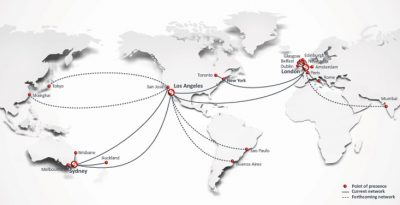With only one day to go until on-line voting closes for the 10th Annual VES Awards, we thought we’d take a look at one of the companies who helped make the awards possible on a global scale – Sohonet.
Award submissions
 Known for its key role in global feature film and broadcast production via an independent media network, Sohonet’s system allowed for the submission of 400 VES Awards entries to the Visual Effects Society and the delivery of high quality viewings at the nomination judgings held over one day in several locations across the globe.
Known for its key role in global feature film and broadcast production via an independent media network, Sohonet’s system allowed for the submission of 400 VES Awards entries to the Visual Effects Society and the delivery of high quality viewings at the nomination judgings held over one day in several locations across the globe.
“We’ve done this for the VES for several years now,” Sohonet general manager Dave Scammell told fxguide. “It can be pretty difficult for people to pull together the submissions for the awards ceremony when you have to lay it onto tape and say send the tape across and copy tapes, particularly for the smaller facilities or individuals in the VES.”
The awards submission process was completed entirely online and relied on Sohonet’s QC System. It was also able to notify nominees if uploaded material did not meet certain requirements, such as image and audio codec and resolution.
“It also had to do this securely,” says Scammell, “especially as most of the material is about projects that are either not released or are about to be released. What we needed was to come up with something very simple to comply with security and also quality requirements.”
“And one of the unique things about the VES Awards,” adds Scammell, “is that all the nominations are judged around the world – at London, New York, Los Angeles, San Francisco, Vancouver, Toronto, Sydney and Wellington. At these events, all the judging members see the work in good quality on the big screen and go through all the nominations. It’s a great way to have your peers judging your work in the best possible way.”
For Sohonet, the company’s VES Awards solution is, like its other services for the production and post production markets, not only about delivering files. “It’s not just about the connectivity,” says Scammell, “it’s all about the workflow. It’s the entire process, whether it’s a production or a broadcaster wanting to get material delivered across the world in a digital format instead of running tapes.”
Private beginnings

Formed in 1995, Sohonet began as a private network in among London post-production facilities and allowed for high-speed and secure sharing of media. Now the company has additional hubs in Los Angeles and Sydney – in addition to its outreach to Europe and North America – and has plans to extend that reach into Asia, firstly via Singapore.
“Singapore is seen by us as a springboard to a lot of the Asian market,” notes Scammell. “There’s a lot of work going on in Singapore, both on the international scale.” India, too, is on the company’s watchlist, although there remain challenges in terms of connectivity expenses from the small number of telecommunication providers in that country.
In addition to widening its network, Sohonet now offers ‘value-added’ cloud and rendering services to its clients. “‘Cloud services’ is a well-known descriptor for that now,” says Scammell. “We have started offering both storage and rendering solutions to enable people to encompass the entire workflow.”
The global production paradigm
“In general,” says Scammell, “we’re seeing an awful amount of activity and we’re seeing an increasing amount of traffic on our network as productions are looking to move and operate more globally. We’ve had to increase our capacity. We’ve just updated our bandwidth down to Australia, but also to Los Angeles and New York and London. We’re expanding as well geographically – we opened up in Vancouver to our first client there, Scanline. And we’re already in Toronto. We’re pretty certain that Singapore will be next on the list.”
Today, the concept of global production seems obvious – and is certainly here to stay – but only 12 years ago the prospect of working in such remote ways seemed less popular. “I was doing a project with the UK government,” recalls Scammell, “and I asked a major US studio if they’d ever take the visual effects work to London if they were shooting for example in Australia and I was laughed out of the room. ‘Why would we do that? Of course we’d do it in the same place?’ Nowadays, people don’t think twice about where the work’s going to be done – whether it’s done for creative purposes, cost savings or convenience.”
fxguide will covering the VES Awards on Tuesday, February 7th from the Beverly Hilton.
